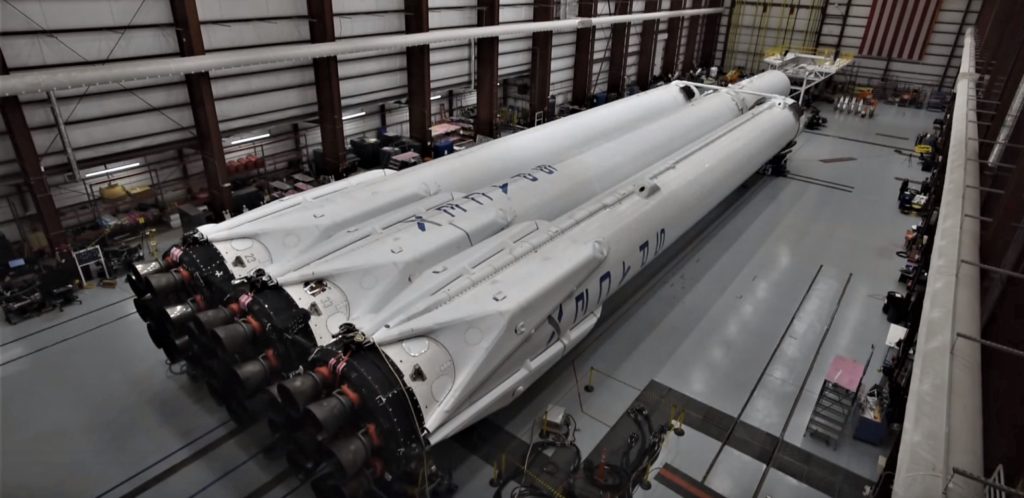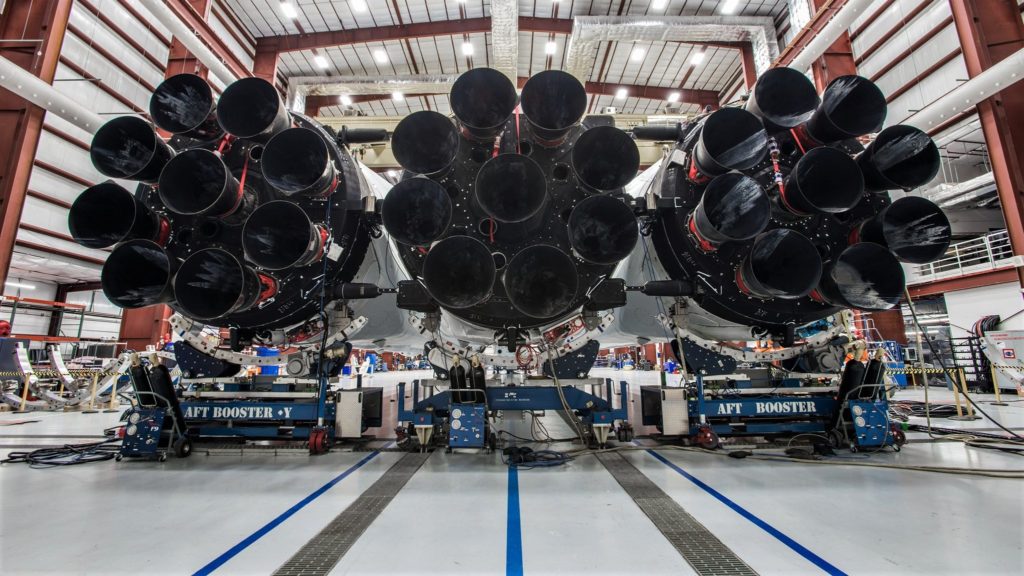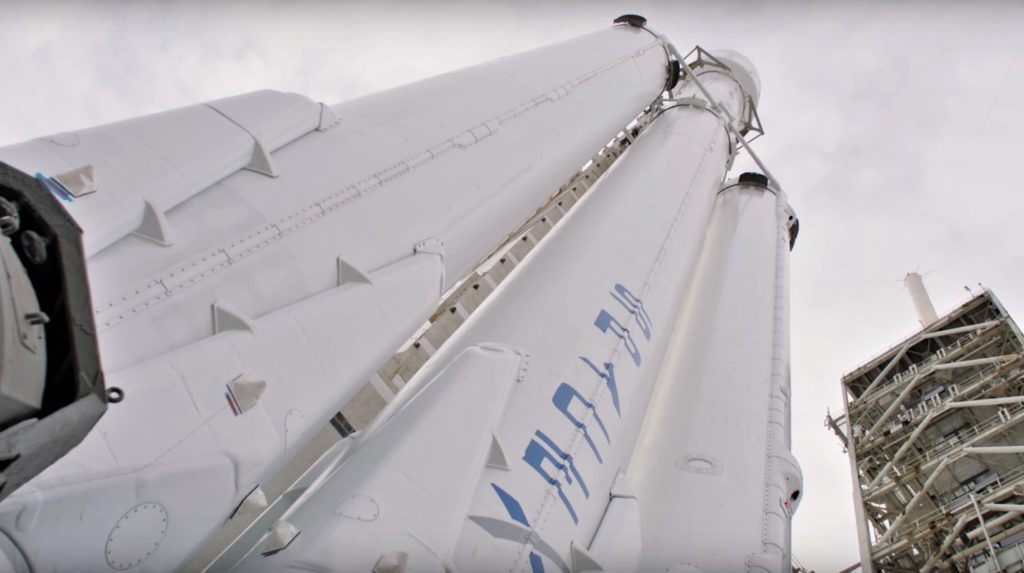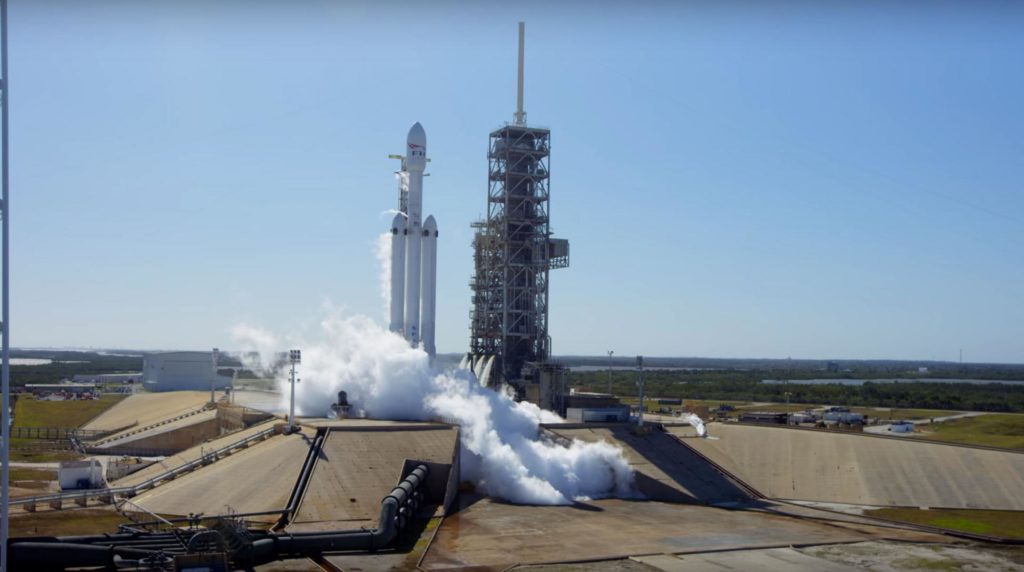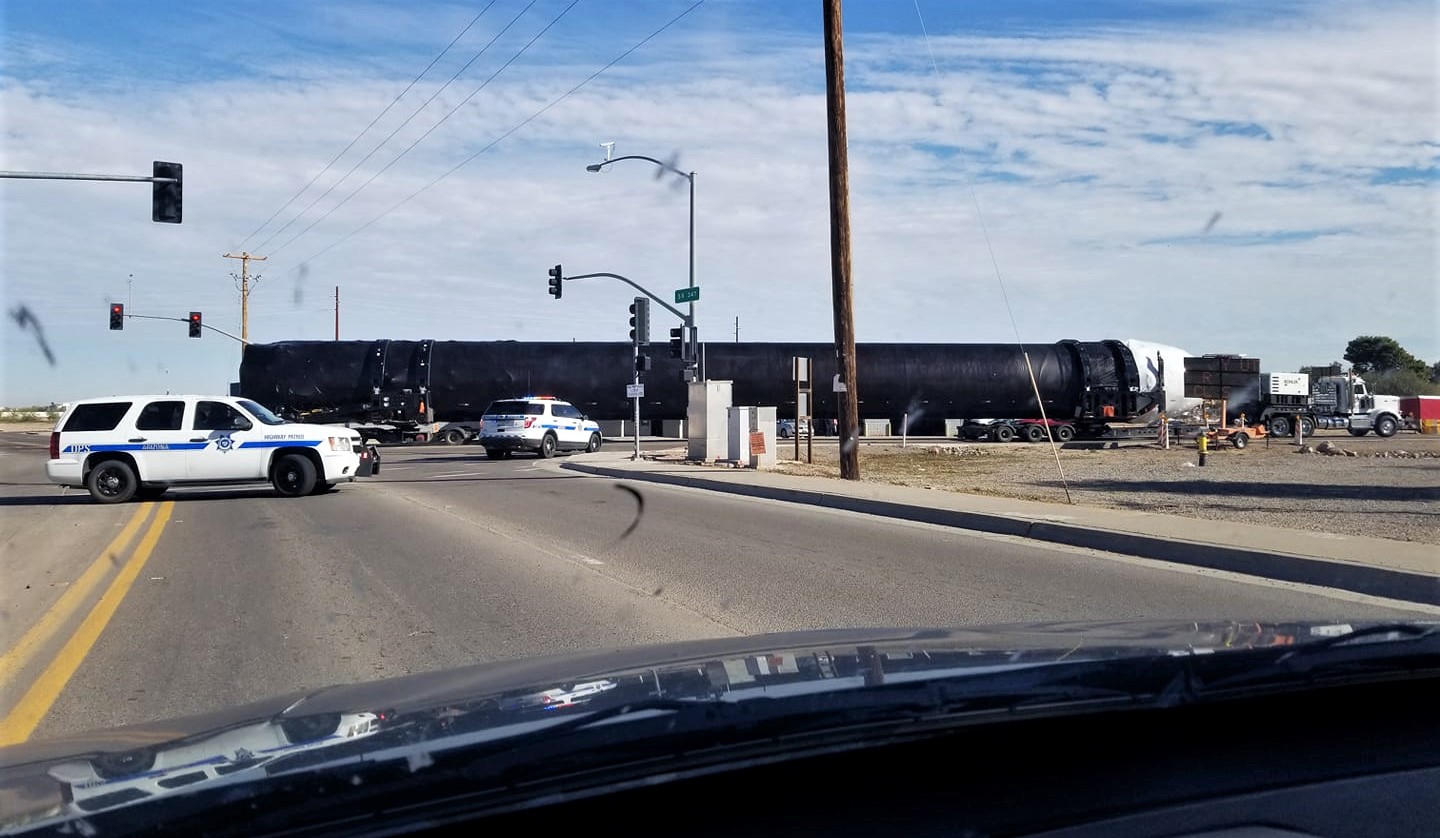
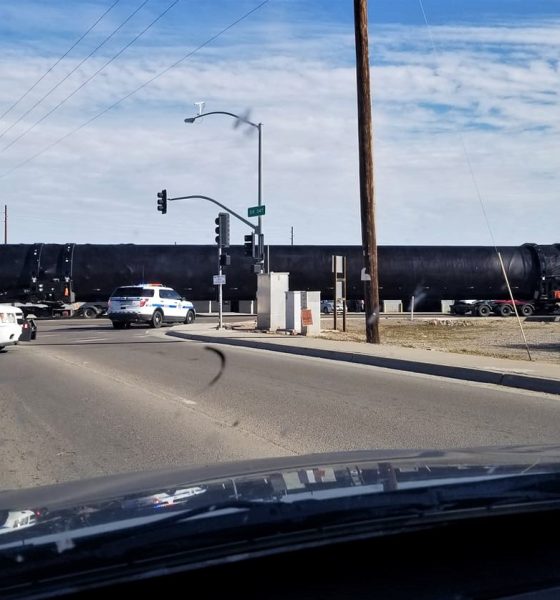
News
SpaceX’s next Falcon Heavy two-thirds done as side booster #2 leaves factory
First posted to a SpaceX-focused Facebook group by member Eric Schmidt, Falcon Heavy Flight 2’s second side booster (of two) was spotted eastbound in Arizona on December 3rd, partway through a journey from SpaceX’s Hawthorne, CA factory to its McGregor, TX testing facilities.
This is the second (known) Falcon Heavy-related booster spotted in less than a month and an incontrovertible sign that the company’s second-ever Falcon Heavy launch is perhaps just a handful of months away, with both side boosters now likely to be present in Florida by January 2019 barring unforeseen developments.
Look who was waving at passing planes over McGregor today!
A Falcon Heavy side booster on the McGregor test stand for a static fire test. pic.twitter.com/S7af6b0gHk
— NSF – NASASpaceflight.com (@NASASpaceflight) November 18, 2018
This second booster appearance follows on the heels of the first Falcon Heavy booster spotting on November 9-10, confirming that – at a minimum – two of the next rocket’s three first stage boosters have finish production and are now focused on completing their separate hot-fire acceptance tests at McGregor. Owing to the ironic fact that the center core – dramatically more complex than its pointy-nosed side core brethren – is far harder to discern while in transport, it’s even possible that the second side core spotting is actually the third new Falcon Heavy booster to depart SpaceX’s factory. The above booster was apparently the second SpaceX first stage to make its way east through Arizona in the week prior to its arrival, so that may well be the case.
SpaceX's second Falcon Heavy is slowly but surely coming together 😀 https://t.co/AYJsQ8Mld5
— Eric Ralph (@13ericralph31) November 13, 2018
While Falcon Heavy side boosters do sport easily recognizable nosecones, they apparently are able to be modified from a Falcon 9 booster to a side booster with no more than a week or two’s work. On the other hand, the rocket’s center booster is dramatically more complex and requires an entirely new custom rocket be built from scratch thanks to the extreme loads it must survive when the two side boosters channel all of their thrust directly into the center core during launch.
However, until the arm-like mechanisms that connect the center stage to its two side boosters are attached, it’s extremely difficult to discern between a normal Falcon 9 booster and a Falcon Heavy center stage. Until a center core is more or less unwrapped and showing off its octaweb or unusual bumps around the interstage, its identity is likely to remain a secret. In the past three months, no fewer than four Falcon boosters arrived at Cape Canaveral, while only one (or maybe two) of them have launched in the time since their arrival.
- SpaceX’s first Falcon Heavy prepares for launch. (SpaceX)
- Falcon Heavy ahead of its inaugural launch. (SpaceX)
- SpaceX’s Falcon Heavy prepares for the huge rocket’s inaugural launch. (SpaceX)
- Falcon Heavy just prior to its first-ever integrated static fire test. (SpaceX)
Given that both side boosters have traveled from California to McGregor, it’s almost certain that Falcon Heavy will fly for the second time with all-new Block 5 hardware, including all three boosters and the upper stage. Most importantly, a Block 5 version of the non-interchangeable center stage should ultimately be able to launch multiple times with zero or minimal refurbishment and repairs, potentially making Falcon Heavy for more viable from a production and internal cost perspective. For a rocket that may only ever launch twice per year, one or two custom center cores could be all that is needed over the vehicle’s operational lifetime, save for any potential launch contract that requires expendable performance.
Ultimately, this second Falcon Heavy booster spotting in less than four weeks is a thrilling sign that SpaceX is pushing extremely hard to have the rocket’s next iteration integrated and ready to launch as soon as possible, perhaps as early as Q1 2019. As its two side boosters begin to arrive in Florida, we should start to have a better idea of when exactly the massive rocket’s second launch might be.
For prompt updates, on-the-ground perspectives, and unique glimpses of SpaceX’s rocket recovery fleet check out our brand new LaunchPad and LandingZone newsletters!

News
Wedbush’s Dan Ives sees ‘monster year’ ahead for Tesla amid AI push
In a post on X, the analyst stated that the electric vehicle maker could hit a $3 trillion market cap by the end of 2026 in a bullish scenario.

Wedbush analyst Dan Ives is doubling down on Tesla’s (NASDAQ:TSLA) long-term upside. In a post on X, the analyst stated that the electric vehicle maker could hit a $3 trillion market cap by the end of 2026 in a bullish scenario, thanks to the company’s efforts to develop and push its artificial intelligence programs.
An aggressive valuation upside
Ives, Wedbush’s global head of tech research, stated in his post that Tesla is entering a pivotal period as its autonomy and robotics ambitions move closer to commercialization. He expects Tesla’s market cap to reach $2 trillion in 2026, representing roughly 33% upside from current levels, with a bull case up to a $3 trillion market cap by year-end.
Overall, Ives noted that 2026 could become a “monster year” for TSLA. “Heading into 2026, this marks a monster year ahead for Tesla/Musk as the autonomous and robotics chapter begins. We believe Tesla hits a $2 trillion market cap in 2026 and in a bull case scenario $3 trillion by end of 2026… as the AI chapter takes hold at TSLA,” the analyst wrote.
Ives also reiterated his “Outperform” rating on TSLA stock, as well as his $600 per share price target.
Unsupervised Full-Self Driving tests
Fueling optimism is Tesla’s recent autonomous vehicle testing in Austin, Texas. Over the weekend, at least two Tesla Model Ys were spotted driving on public roads without a safety monitor or any other occupants. CEO Elon Musk later confirmed the footage of one of the vehicles on X, writing in a post that “testing is underway with no occupant in the car.”
It remains unclear whether the vehicle was supported by chase cars or remote monitoring, and Tesla has not disclosed how many vehicles are involved. That being said, Elon Musk stated a week ago that Tesla would be removing its Safety Monitors from its vehicles “within the next three weeks.” Based on the driverless vehicles’ sightings so far, it appears that Musk’s estimate may be right on the mark, at least for now.
News
Production-ready Tesla Cybercab hits showroom floor in San Jose
Tesla has implemented subtle but significant updates to both the Cybercab’s exterior and interior elements.
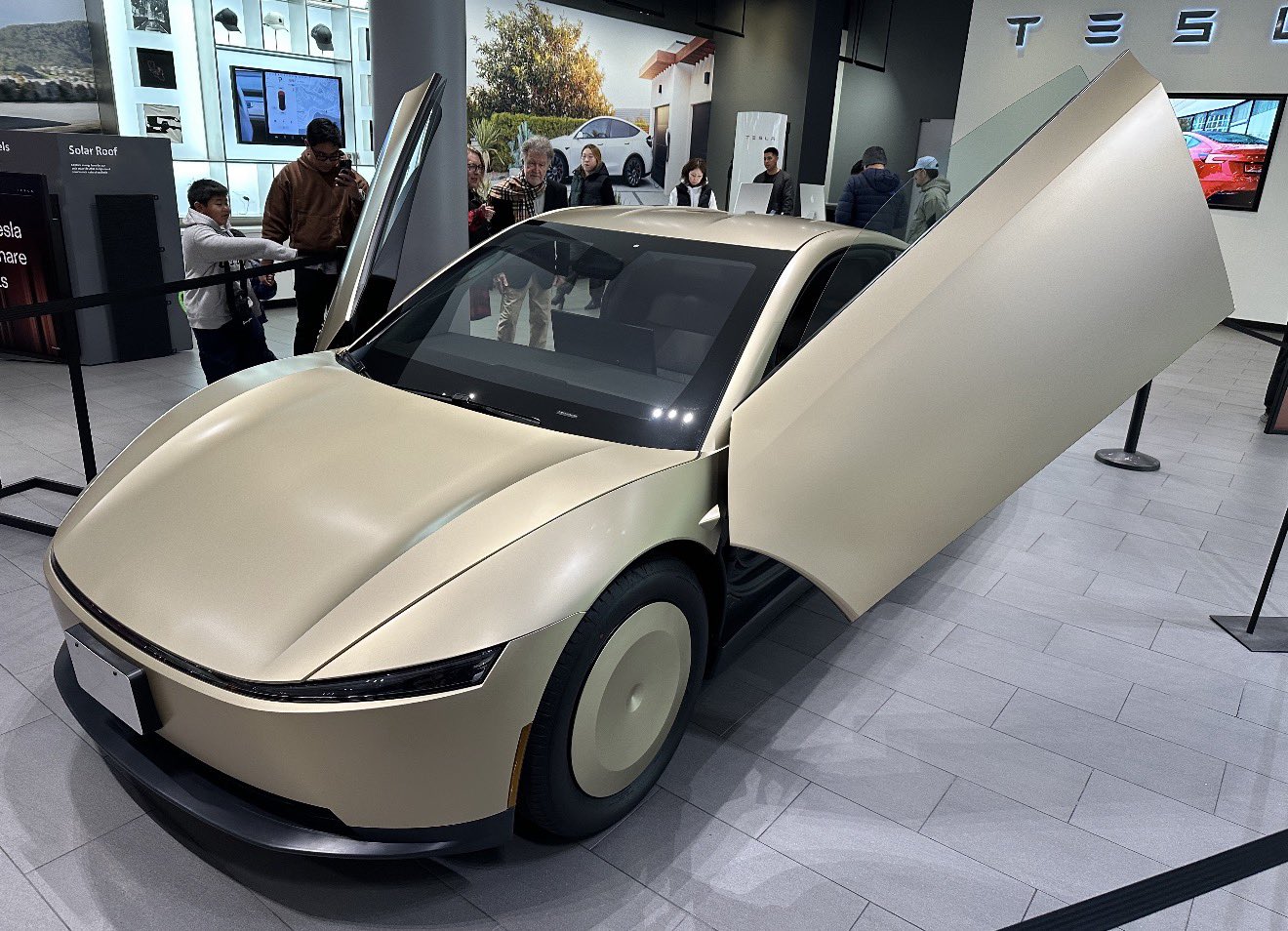
Tesla has showcased what appears to be a near-production-ready Cybercab at its Santana Row showroom in San Jose, California, giving visitors the closest look yet at the autonomous two-seater’s refined design.
Based on photos of the near-production-ready vehicle, the electric vehicle maker has implemented subtle but significant updates to both the Cybercab’s exterior and interior elements, making the vehicle look more polished and seemingly more comfortable than its prototypes from last year.
Exterior and interior refinements
The updated Cybercab, whose photos were initially shared by Tesla advocate Nic Cruz Patane, now features a new frameless window design, an extended bottom splitter on the front bumper, and a slightly updated rear hatch. It also includes a production-spec front lightbar with integrated headlights, new wheel covers, and a license plate bracket.
Notably, the vehicle now has two windshield wipers instead of the prototype’s single unit, along with powered door struts, seemingly for smoother opening of its butterfly doors. Inside, the Cybercab now sports what appears to be a redesigned dash and door panels, updated carpet material, and slightly refined seat cushions with new center cupholders. Its legroom seems to have gotten slightly larger as well.
Cybercab sightings
Sightings of the updated Cybercab have been abundant in recent months. At the end of October, the Tesla AI team teased some of the autonomous two-seater’s updates after it showed a photo of the vehicle being driven through an In-N-Out drive-through by employees in Halloween costumes. The photos of the Cybercab were fun, but they were significant, with longtime Tesla watchers noting that the company has a tradition of driving its prototypes through the fast food chain’s drive-throughs.
Even at the time, Tesla enthusiasts noticed that the Cybercab had received some design changes, such as segmented DRLs and headlamps, actual turn signals, and a splitter that’s a lot sharper. Larger door openings, which now seem to have been teasing the vehicle’s updated cabin, were also observed at the time.
Investor's Corner
Tesla analyst realizes one big thing about the stock: deliveries are losing importance
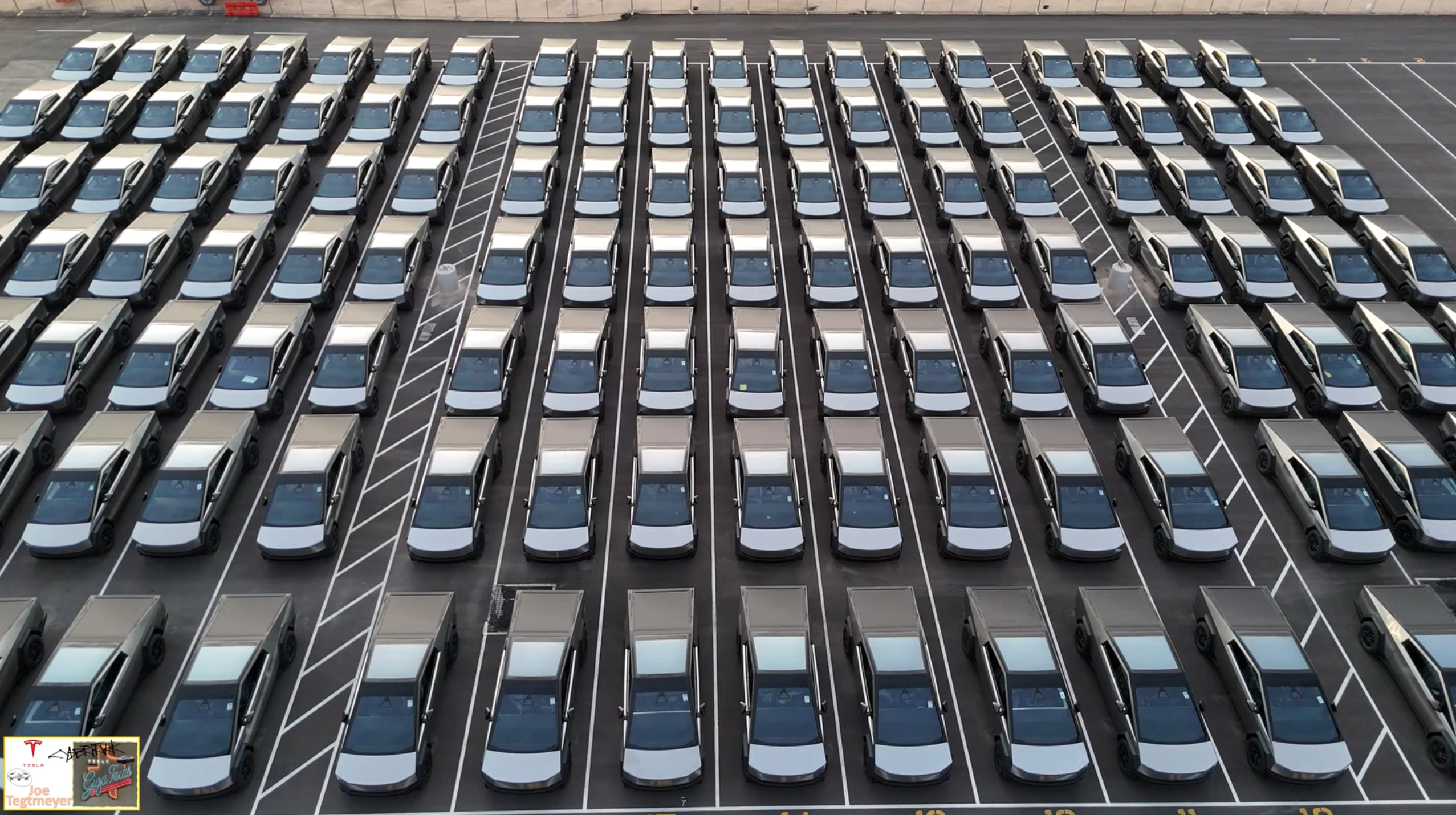
Tesla analyst Dan Levy of Barclays realized one big thing about the stock moving into 2026: vehicle deliveries are losing importance.
As a new era of Tesla seems to be on the horizon, the concern about vehicle deliveries and annual growth seems to be fading, at least according to many investors.
Even CEO Elon Musk has implied at times that the automotive side, as a whole, will only make up a small percentage of Tesla’s total valuation, as Optimus and AI begin to shine with importance.
He said in April:
“The future of the company is fundamentally based on large-scale autonomous cars and large-scale and large volume, vast numbers of autonomous humanoid robots.”
Almost all of Tesla’s value long-term will be from AI & robots, both vehicle & humanoid
— Elon Musk (@elonmusk) September 11, 2023
Levy wrote in a note to investors that Tesla’s Q4 delivery figures “likely won’t matter for the stock.” Barclays said in the note that it expects deliveries to be “soft” for the quarter.
In years past, Tesla analysts, investors, and fans were focused on automotive growth.
Cars were truly the biggest thing the stock had to offer: Tesla was a growing automotive company with a lot of prowess in AI and software, but deliveries held the most impact, along with vehicle pricing. These types of things had huge impacts on the stock years ago.
In fact, several large swings occurred because of Tesla either beating or missing delivery estimates:
- January 3, 2022: +13.53%, record deliveries at the time
- January 3, 2023: -12.24%, missed deliveries
- July 2, 2024: +10.20%, beat delivery expectations
- October 3, 2022: -8.61%, sharp miss due to Shanghai factory shutdown
- July 2, 2020: +7.95%, topped low COVID-era expectations with sizeable beat on deliveries
It has become more apparent over the past few quarters that delivery estimates have significantly less focus from investors, who are instead looking for progress in AI, Optimus, Cybercab, and other projects.
These things are the future of the company, and although Tesla will always sell cars, the stock is more impacted by the software the vehicle is running, and not necessarily the vehicle itself.
